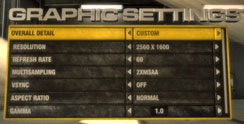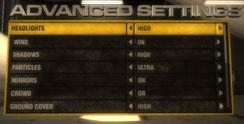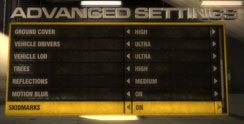Race Driver: GRID
Publisher: CodemastersRace Driver: GRID is one of the best racing games to grace the PC in some time, striking a fine balance between automotive simulation and arcade throttle-fest which has resulted in an enormously entertaining game. Players can choose from racing tuned saloons through city streets, through to driving Lamborghinis around Le Mans, with all cars displaying a highly detailed damage model.
GRID runs on a modified version of Codemasters' own in house Neon engine, rechristened Ego for GRID. This will also be the engine used in the highly anticipated Operation Flashpoint 2: Dragon Rising, so hopefully GRID will give us a good indication of how hardware will perform in this future title too. Despite only supporting DirectX 9.0c, GRID features a lot of high level graphical features, including motion blur, fantastic smoke effects, dynamic track side details and thousands of fully 3D spectators.
To test performance in GRID, we raced a lap of the "San Francisco Short Circuit" track in the RADT Nissan Skyline Z-tune, starting from the back of the grid to ensure as many cars on screen for as long as possible. We chose the San Francisco circuit due to the large amount of dynamic track side details like flags and spectators visible from the track, and for the close proximity of track side objects.
However, GRID does not support anisotropic filtering in game, so we had to force this to 16x using the Forceware and Catalyst drivers. We captured the average and minimum frame rates during the lap, and the results you see below are indicative of around one minute and forty seconds of gameplay (average lap time) per setting.
The final game test Race Driver: GRID ended on a familiar note where again the MSI GTX 285 HydroGen OC failed to prove its worth in raw performance terms over the stock GTX 285. At 1,680 x 1,050 4xAA 16xAF the difference in minimum frame rate was just 2fps with the MSI GTX 285 HydroGen OC managing 76fps which is within our margin of error for this manual benchmark.
At our maximum resolution of 2,560 x 1,600 with 4xAA 16xAF, the difference was barely distinguishable with the stock GTX 285 actually posting results slightly ahead of the MSI GTX 285 HydroGen OC, although the average was slower. Race Driver: GRID is a pretty easy task for most graphics cards though, so if it's the only game you're interested in, you can get away with a much cheaper card even if you own a 24in 1920x1200 monitor.

MSI MPG Velox 100R Chassis Review
October 14 2021 | 15:04












Want to comment? Please log in.